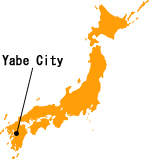


|
An aqueduct bridge to carry water through space
Built in 1854, Tsujunkyo Bridge is Japan's largest stone-arch aqueduct bridge. The bridge has a width of 6.3 m (6.9 yd.) and a length of 75.6 m (83.2 yd.). The arch diameter is 28.2 m (31 yd.), which gives the structure a maximum height of 20.2 m (22.2 yd.) over the Todoroki River in Yabe Town, Kumamoto Prefecture on Kyushu, which is the southern island of Japan. The stone-built bridge, which creates a large and elegant arc through space, is recognized by the Japanese government an Important Cultural Property. Yabe Town is located in the Shiroito Plateau where, before the aqueduct was built, not only was it difficult to farm because the water supply was inadequate, but the local people were unable to get enough daily drinking water. Although rivers flowed above the Shiroito Plateau in the area, direct access to this water was denied by a deep ravine formed by the Todoroki River. It was also impossible for economic and technical reasons to build a bridge across the ravine. The technical solution was to build a stone aqueduct bridge at a height where it was possible to traverse the ravine. Then, after bringing the water down to the level of the aqueduct bridge, the water was lifted to the opposite side of the Plateau using the reverse siphon principle.
A total of 30,000 people worked on the project, and the stone bridge was completed after 20 months of work. Even today, 100 ha (250 acres) of rice farm on the Shiroito Plateau are irrigated by water from the Tsujunkyo Bridge. Center ducts on the sides of the aqueduct bridge can be opened to flush out the sand and debris that collect inside, and during the Hassaku Festival held annually on the first Saturday in September, the splendid cascade of water that gushes out from the ducts is a famous sight. Photo: (top) Tsujunkyo Bridge, (bottom) The splendid cascade of water that gushes out from the ducts of Tsujinkyo Bridge (Yabe Town) Unauthorized reproduction of the
photos in this page is prohibited.
Related Links: |
|

